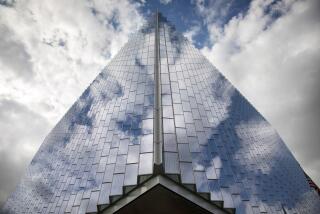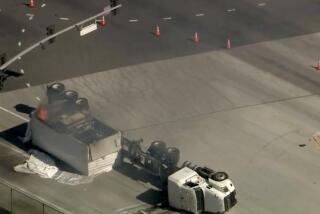Star Light, Star Bright
Fireworks have come a long way since the 12th century when the Chinese set fire to bamboo stuffed with saltpeter, sulfur and charcoal.
Today, the most advanced fireworks have entered the computer age.
Elaborate shows--including those seen at Dodgers and Angels baseball games--use a new digital firing system that allows for precision timing.
As increasing numbers of cities in recent years have outlawed backyard fireworks, people have flocked to professional holiday shows.
Possession, sale and discharge of fireworks are illegal in the city of Los Angeles, as well as 52 of the 88 incorporated cities in Los Angeles County and all unincorporated county areas.
Locally, only Palmdale permits limited sales and discharge of fireworks within city limits.
Here’s a look at just how fireworks operate:
Behind the Scenes
The California State Fire Marshal has licensed 482 people to perform fireworks shows. Usually, two people light the fireworks, while four others reload the mortars and several others monitor the explosions.
*
The Shell
1. Two to three feet of fast fuse is hand-lit using a road flare.
2. Fuse carries fire to gunpowder lift charge.
3. Charge explodes, propelling shell into the air at 300 to 400 mph.
4. A separate shell fuse ignites the burst charge about four seconds after the lift charge.
5. Chemical cubes in shell explode producing colored sparks.
*
The Mortar
Cardboard or metal mortar: 3- to 6-inch diameter, buried to three quarters of its length.
Sky Designs
Fireworks patterns include peony, chrysanthemum, spiderweb, palm tree, red-tipped comet and finale. The pattern is produced by the size of the glittering “stars,” the type of packing inside a shell and the shape of the shell itself.
United Colors
Red: Strontium nitrate or carbonate
Blue: Copper salts
Yellow: Sodium salts
Green: Barium nitrate or chlorate
Orange/amber: Charcoal or iron
White: Magnesium or aluminum powder
A Pretty Penny
In a professional show, fireworks are both plentiful and costly. An average of 250 fireworks are discharged during a small show and up to 500 in a large show, plus 150 in the finale. The small shows cost about $7,500 and run about 12 minutes while the bigger ones can run $12,000 to $15,000 and last 20 minutes.
July 4th Events
* Cal State Northridge North Campus
Zelzah Avenue and Devonshire Street
Gates open at noon, entertainment at 1 p.m., fireworks at 9 p.m.
Admission: $8 adults, $5 seniors and children ages 5-11. Free parking prior to 4 p.m., after 4 p.m., parking $3/car.
(818) 349-5680
* Starlight Bowl
1249 Lockheed View Drive
Burbank
Gates open at 6 p.m., entertainment at 6:30 p.m., fireworks at 9 p.m.
Admission: $20 box seats, $10 and $7 reserved, $5 lawn seats, $5 seniors 60 and older, children 12 and under and wheelchair seating.
(818) 238-5300
* Recreation Park
208 Park Ave.
San Fernando
Family activities begin at 11 a.m., entertainment at 2 p.m., fireworks at dusk.
Admission: free
(818) 361-7155
* Crescenta Valley High School
4400 Ramsdell Ave.
La Crescenta
Gates open at noon for daylong carnival, fireworks at 9 p.m.
Admission: $6 general admission, free for children under 5
(818) 248-4957
* Antelope Valley Fairgrounds
Division Street and Avenue I
Lancaster
Gates open at 6 p.m., entertainment at 6:15 p.m., fireworks at 9 p.m
Admission: free
(805) 723-6077
* Palmdale High School
2137 E. Avenue R
Gates open at 6:30 p.m., entertainment at 7:30 p.m., fireworks at 9 p.m.
Admission: free
(805) 273-3232
For information about professional fireworks shows throughout Los Angeles County, call (800) 900-FIRE. Often shows sell out, so purchase tickets in advance when possible.
Sources: Pyro Spectaculars Inc., California State Fire Marshal, Los Angeles County Fire Department. Researched by STEPHANIE STASSEL/Los Angeles Times
More to Read
Sign up for Essential California
The most important California stories and recommendations in your inbox every morning.
You may occasionally receive promotional content from the Los Angeles Times.










